
Embark on a journey to explore the future of ski resorts in Europe for 2025, where innovation meets tradition in the snowy slopes of the Alps and beyond. Get ready to discover the top emerging destinations, technological advancements, and more in this exciting narrative.
As we glide through the changes and developments in the ski resort industry, you’ll uncover a world of possibilities for your next winter escapade in Europe.
Ski Resorts in Europe 2025

As of 2025, ski resorts in Europe continue to be popular destinations for winter sports enthusiasts from around the world. The current state of ski resorts in Europe showcases a mix of traditional alpine villages and modern resort towns, offering a wide range of amenities and activities for visitors.
Comparison of Ski Resort Development
In comparing the trends in ski resort development between 2020 and projected 2025, we see a continued focus on sustainability and eco-friendly practices. Many ski resorts have implemented green initiatives to reduce their environmental impact, such as using renewable energy sources and promoting responsible tourism. Additionally, there has been an increase in the development of luxury accommodations and high-end facilities to attract a more upscale clientele.
Top Emerging Ski Resort Destinations
One of the top emerging ski resort destinations in Europe for 2025 is the Balkan region, specifically countries like Bulgaria and Romania. These destinations offer affordable skiing options with modern infrastructure and stunning mountain landscapes. Another emerging destination is Norway, known for its pristine nature and unique skiing experiences, attracting adventure seekers looking for something off the beaten path.
Technological Advancements Impacting Ski Resorts
Technological advancements expected to impact ski resorts by 2025 include the use of artificial intelligence and data analytics to improve guest experiences and optimize operations. Ski resorts are incorporating smart technology into their services, such as automated lift ticket systems, personalized mobile apps for tracking ski routes, and snow-making machines with advanced climate control capabilities. These advancements aim to enhance overall efficiency and convenience for visitors, ultimately shaping the future of ski resort experiences in Europe.
SPORTS TENNIS
Tennis is a widely popular sport worldwide, known for its fast-paced action, strategic gameplay, and individual competition. Players compete on different surfaces such as grass, clay, and hard courts, showcasing their skills and athleticism.
Key Skills for Professional Tennis
- Excellent hand-eye coordination
- Strong footwork and agility
- Powerful serve and accurate shots
- Mental toughness and focus
- Strategic thinking and adaptability
Playing Singles vs Doubles
Playing singles in tennis requires more stamina and individual skill, as players are responsible for covering the entire court. On the other hand, doubles tennis involves teamwork, communication, and coordinated movements with a partner to outsmart the opposing team.
Impact of Technology in Tennis
- Advanced racquet technologies improve power and control in shots.
- Video analysis helps players review and refine their technique.
- Fitness trackers and wearables monitor players’ performance and physical condition.
- Hawk-Eye technology assists in line-calling accuracy during matches.
WATER SPORTS
When it comes to water sports in Europe, there are several popular activities that attract enthusiasts from around the world. From surfing to kayaking and paddleboarding, there are plenty of options for those seeking adventure on the water.
Most Popular Water Sports in Europe
- Surfing: Surfing is a favorite water sport in Europe, especially in coastal regions with great waves. Surfers use a surfboard to ride the waves, showcasing their skills and agility.
- Kayaking: Kayaking involves paddling a kayak through rivers, lakes, or even the sea. It’s a great way to explore scenic waterways and enjoy the tranquility of nature.
- Paddleboarding: Paddleboarding has gained popularity in recent years, with enthusiasts standing on a board and paddling through calm waters. It’s a relaxing and fun activity for all ages.
Equipment Comparison for Water Sports
Each water sport requires specific equipment to ensure safety and enjoyment. Here’s a comparison of the gear needed for surfing, kayaking, and paddleboarding:
| Water Sport | Equipment |
|---|---|
| Surfing | Surfboard, wetsuit, leash, wax |
| Kayaking | Kayak, paddle, life jacket, helmet |
| Paddleboarding | Paddleboard, paddle, leash, personal flotation device |
Environmental Impact and Sustainability in Water Sports
Water sports can have an impact on the environment, especially in terms of pollution and disturbance to marine life. To promote sustainability, measures such as using eco-friendly gear, cleaning up after oneself, and supporting marine conservation efforts are essential.
Upcoming Trends in Water Sports
- Electric Surfboards: Electric surfboards are becoming more popular, offering a thrilling experience with less effort.
- Eco-Friendly Gear: The trend towards sustainable and biodegradable water sports gear is expected to continue, reducing the environmental footprint of enthusiasts.
- Virtual Reality Water Sports: With advancements in technology, virtual reality water sports experiences are likely to emerge, allowing people to enjoy the thrill of water sports from anywhere.
WINTER SPORTS
Winter sports are immensely popular in Europe, attracting millions of tourists each year seeking thrilling outdoor adventures in the snow-covered mountains. From skiing to snowboarding and ice skating, there is something for everyone to enjoy during the winter season.
Most Popular Winter Sports in Europe
- Skiing: Skiing is the most popular winter sport in Europe, with a wide range of slopes catering to all skill levels. Whether you’re a beginner or an expert, there are plenty of opportunities to hit the slopes and experience the adrenaline rush of gliding down the mountains.
- Snowboarding: Snowboarding has gained popularity in recent years, especially among younger generations. With its own unique set of challenges and techniques, snowboarding offers a thrilling alternative to traditional skiing.
- Ice Skating: Ice skating is a classic winter sport enjoyed by people of all ages. Whether you prefer figure skating or speed skating, ice rinks across Europe provide the perfect setting for a fun day on the ice.
Safety Measures and Precautions
Before engaging in any winter sport, it is important to prioritize safety to avoid accidents and injuries. Some essential safety measures include:
- Wearing appropriate protective gear such as helmets and padding.
- Familiarizing yourself with the rules of the slopes and ice rinks.
- Staying hydrated and taking breaks to prevent fatigue.
- Checking weather conditions and avalanche risks before heading out.
Skill Requirements Comparison
While skiing, snowboarding, and ice skating all require balance, coordination, and agility, there are distinct differences in the skill sets needed for each sport:
“Skiing requires mastering techniques such as parallel turning and carving, while snowboarding focuses on edge control and freestyle tricks. Ice skating demands grace and precision in movements on the ice.”
Economic Impact of Winter Sports Tourism
Winter sports tourism plays a significant role in the economies of European countries, contributing to job creation, infrastructure development, and revenue generation. Countries with popular ski resorts benefit from increased tourism during the winter season, boosting local businesses and stimulating economic growth.
Epilogue

From cutting-edge technologies to picturesque landscapes, the ski resorts in Europe for 2025 promise an unforgettable experience for all winter sports enthusiasts. Start planning your snowy getaway now and get ready to hit the slopes in style!
FAQ Resource
What are the top emerging ski resort destinations in Europe for 2025?
Some of the top emerging destinations include X, Y, and Z, known for their pristine slopes and modern amenities.
How will technological advancements impact ski resorts by 2025?
Technological advancements are expected to revolutionize the ski resort experience with features like AI-powered snowmaking and smart lift systems.
What safety measures are necessary for engaging in winter sports?
Key safety measures include wearing appropriate gear, staying on designated trails, and being aware of weather conditions for a safe winter sports experience.
How do singles and doubles in tennis differ?
Singles in tennis involve one player on each side of the court, while doubles have two players on each side, requiring different strategies and coordination.
What are the environmental impacts of water sports?
Water sports can have environmental impacts like pollution and habitat destruction, but measures like beach clean-ups and eco-friendly gear can promote sustainability.

